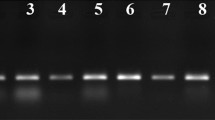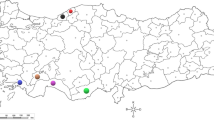Abstract
Verticillium dahliae has been recently characterized as a heterothallic fungus having two MAT idiomorphs, MAT1-1 and MAT1-2, which suggested that a putative sexual life cycle of the pathogen might exist. A successful mating in heterothallic fungi requires two individuals of opposite mating types present together in the same site. Co-occurrence of both mating types of V. dahliae has been investigated in many parts of the world but not comprehensively in Turkey. This study aims at determination of the mating types in V. dahliae populations in the major cotton producing districts of Aydın Province. A total of 123 V. dahliae isolates obtained from cotton were subjected to PCR assay with the two pairs of specific primers for mating type determination. All of the isolates produced a single amplicon approximately 600 bp in size, which is known belonging to MAT1-2 idiomorph. The results suggested that MAT1-1 has not been introduced yet to the Aydın Province. Absence of MAT1-1 idiomorph will deprive the pathogen from sexual reproduction and this maintains that the pathogen population remains clonal with presumably having low levels of genetic diversity.

Similar content being viewed by others
References
Atallah ZK, Maruthachalam K, Du Toit L, Koike ST, Davis RM, Klosterman SJ et al (2010) Population analyses of the vascular plant pathogen Verticillium dahliae detect recombination and transcontinental gene flow. Fungal Genet Biol 47:416–422
Atallah ZK, Hayes RJ, Subbarao KV (2011) Fifteen years of Verticillium wilt of lettuce in America’s salad bowl: a tale of immigration, subjugation, and abatement. Plant Dis 95:784–792
Atallah ZK, Maruthachalam K, Subbarao KV (2012) Sources of Verticillium dahliae affecting lettuce. Phytopathology 102:1071–1078
Bejarano-Alcázar J, Blanco-López MA, Melero-Vara JM, Jiménez-Díaz RM (1996) Etiology, importance, and distribution of Verticillium wilt of cotton in southern Spain. Plant Dis 80(11):1233–1238
Bhat RG, Subbarao KV (1999) Host range specificity in Verticillium dahliae. Phytopathology 89:1218–1225
Dervis S, Bicici M (2005) Vegetative compatibility groups in Verticillium dahliae isolates from cotton in Turkey. Phytoparasitica 33:157–168
Dervis S, Kurt S, Soylu S, Erten L, Soylu EM, Yildiz M et al (2008) Vegetative compatibility groups of Verticillium dahliae from cotton in the Southeastern Anatolia region of Turkey. Phytoparasitica 36:74–83
Dervis S, Mercado-Blanco J, Erten L, Valverde-Corredor A, Pérez-Artés E (2010) Verticillium wilt of olive in Turkey: a survey on disease importance, pathogen diversity and susceptibility of relevant olive cultivars. Eur J Plant Pathol 127(2):287–301
Dinler H, Benlioğlu S (2013) Vegetative compatibility groups (VCGs) of Verticillium dahliae Kleb. Isolates obtained from the cotton-growing areas of Aydın province. Bitki Koruma Bülteni 53(2):85–99
DuToit LJ, Derie ML, Hernandez-Perez P (2005) Verticillium wilt in spinach seed production. Plant Dis 89:4–11
Dung JKS, Peever TL, Johnson DA (2013) Verticillium dahliae populations from mint and potato are genetically divergent with predominant haplotypes. Phytopathology 103:445–459
Erdogan O, Nemli S, Oncu T, Tanyolac B (2013) Genetic variation among pathotypes of Verticillium dahliae Kleb from cotton in western Turkey revealed by AFLP. Can J Plant Pathol. 35(3):354–362
Gerik JS, Huisman OC (1988) Study of field-grown cotton roots infected with Verticillium dahliae using an immunoenzymatic staining technique. Phytopathology 78:1174–1178
Göre ME (2007) Vegetative compatibility and pathogenicity of Verticillium dahliae isolates from the aegean region of Turkey. Phytoparasitica 35(3):222–231
Göre ME, Esen H, Orak A, Gözcü D, Altın N, Erdoğan O (2007) Pathotype groups within Verticillium dahliae isolates from cotton in Turkey. Anadolu 17(1):16–42
Gurung S, Short DPG, Atallah ZK, Subbarao KV (2014) Clonal expansion of Verticillium dahliae in lettuce. Phytopathology 104:641–649
Klosterman SJ, Atallah ZK, Vallad GE, Subbarao KV (2009) Diversity, pathogenicity, and management of Verticillium species. Ann Rev Phytopathol 47:39–62
Korolev N, Katan J, Katan T (2000) Vegetative compatibility groups of Verticillium dahliae in Israel: their distribution and association with pathogenicity. Phytopathology 90:529–566
Milgroom MG, Sotirovski K, Spica D, Davis JE, Brewer MT, Milev M et al (2008) Clonal population structure of the chestnut blight fungus in expanding ranges in southeastern Europe. Mol Ecol 17(20):4446–4458
Milgroom MG, Jimenez-GascoM DM, García CO, Drott MT, Jiménez-Díaz RM (2014) Recombination between clonal lineages of the asexual fungus Verticillium dahliae detected by genotyping by sequencing. PLoS ONE 9(9):1–12
Milgroom MG, Del Mar J-G, Olivares-Garcia C, Jimenez-Diaz RM (2016) Clonal expansion and migration of a highly virulent, defoliating lineage of Verticillium dahliae. Phytopathology 106(9):1038–1046
Shaban M, Miao Y, Ullah A, Khan AQ, Menghwar H, Khan AH et al (2018) Physiological and molecular mechanism of defense in cotton against Verticillium dahliae. Plant Physiol Biochem 125:193–204
Short DP, Gurung S, Hu X, Inderbitzin P, Subbarao KV (2014) Maintenance of sex-related genes and the co-occurrence of both mating types in Verticillium dahliae. PLoS ONE 9(11):1–14
Short DP, Gurung S, Gladieux P, Inderbitzin P, Atallah ZK, Nigro F et al (2015) Globally invading populations of the fungal plant pathogen Verticillium dahliae are dominated by multiple divergent lineages. Environ Microbiol 17(8):2824–2840
Strausbaugh CA (1993) Assessment of vegetative compatibility and virulence of Verticillium dahliae isolates from Idaho potatoes and tester strains. Phytopathology 83:1253–1258
Usami T, Itoh M, Amemiya Y (2009a) Asexual fungus Verticillium dahliae is potentially heterothallic. J Gen Plant Pathol 75:422–427
Usami T, Itoh M, Amemiya Y (2009b) Mating type gene MAT1-2-1 is common among Japanese isolates of Verticillium dahliae. Physiol Mol Plant Pathol 73:133–137
Usami T, Itoh M, Morii S, Miyamoto T, Kaneda M, Ogawara T, Amemiya Y (2012) Involvement of two different types of Verticillium dahliae in lettuce wilt in Ibaraki Prefecture, Japan. J Gen Plant Pathol 78(5):348–352
Author information
Authors and Affiliations
Corresponding author
Ethics declarations
Conflict of interest
The author declares that she has no conflict of interest.
Additional information
Publisher's Note
Springer Nature remains neutral with regard to jurisdictional claims in published maps and institutional affiliations.
Rights and permissions
About this article
Cite this article
Erincik, B.G. Mating types of Verticillium dahliae isolates from cotton in Aydın Province/Turkey. J Plant Dis Prot 127, 677–681 (2020). https://doi.org/10.1007/s41348-020-00321-1
Received:
Accepted:
Published:
Issue Date:
DOI: https://doi.org/10.1007/s41348-020-00321-1




